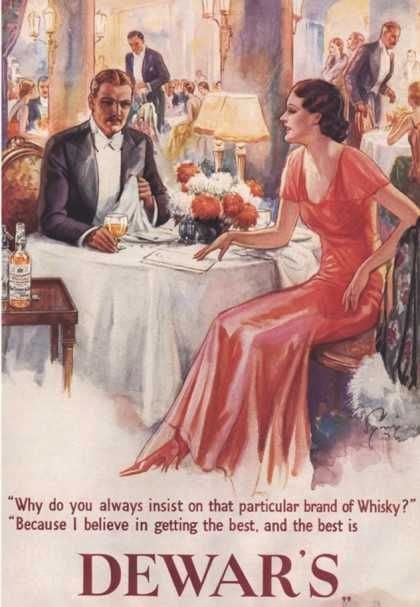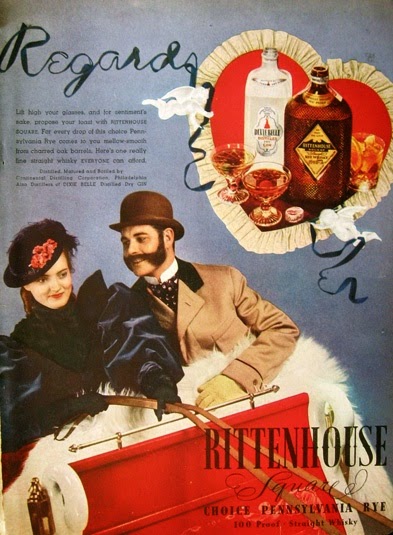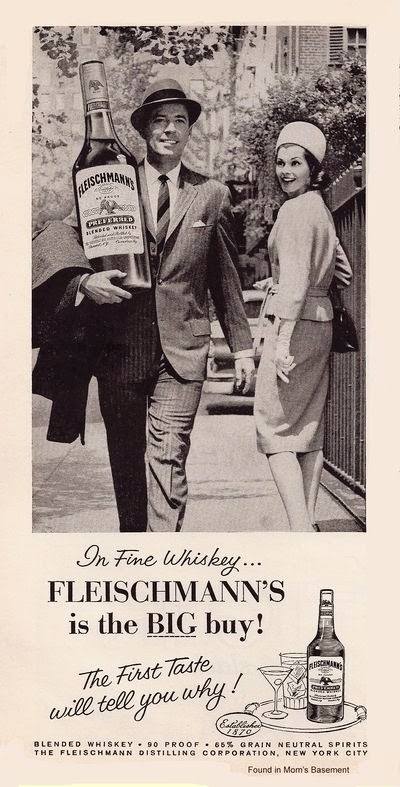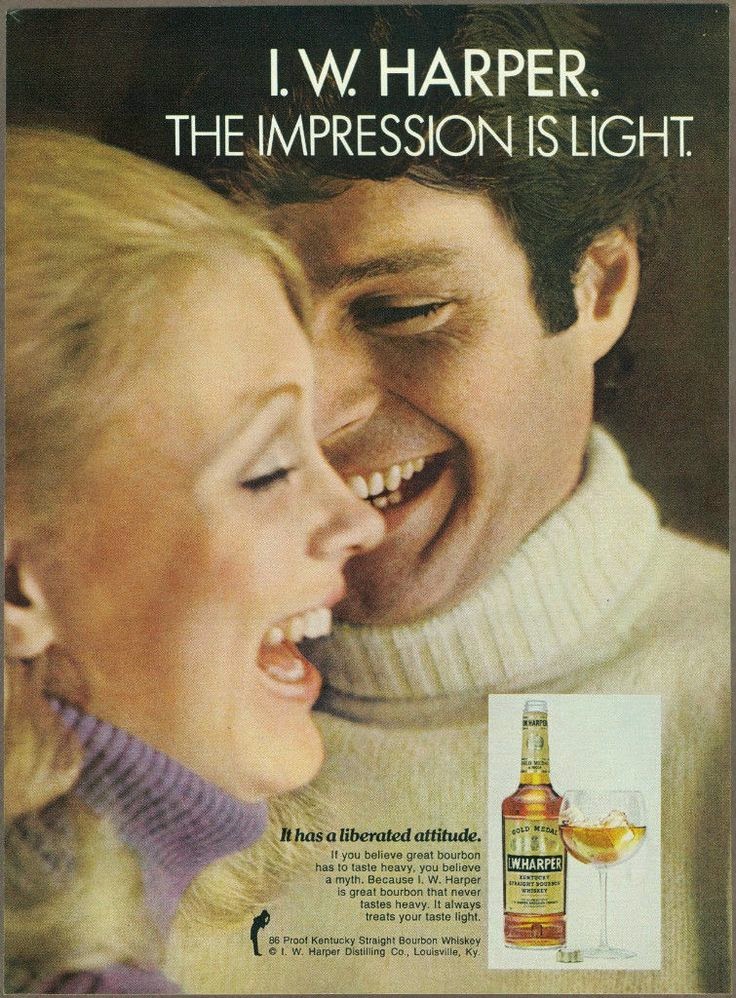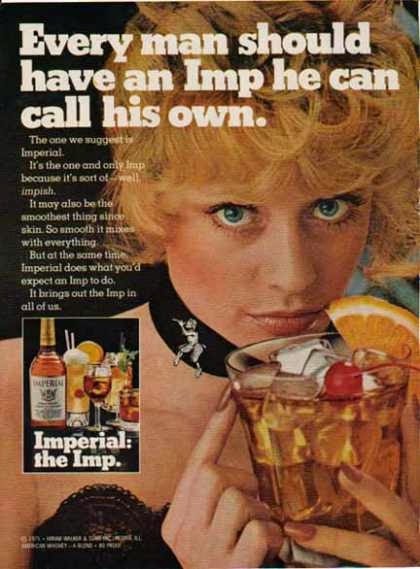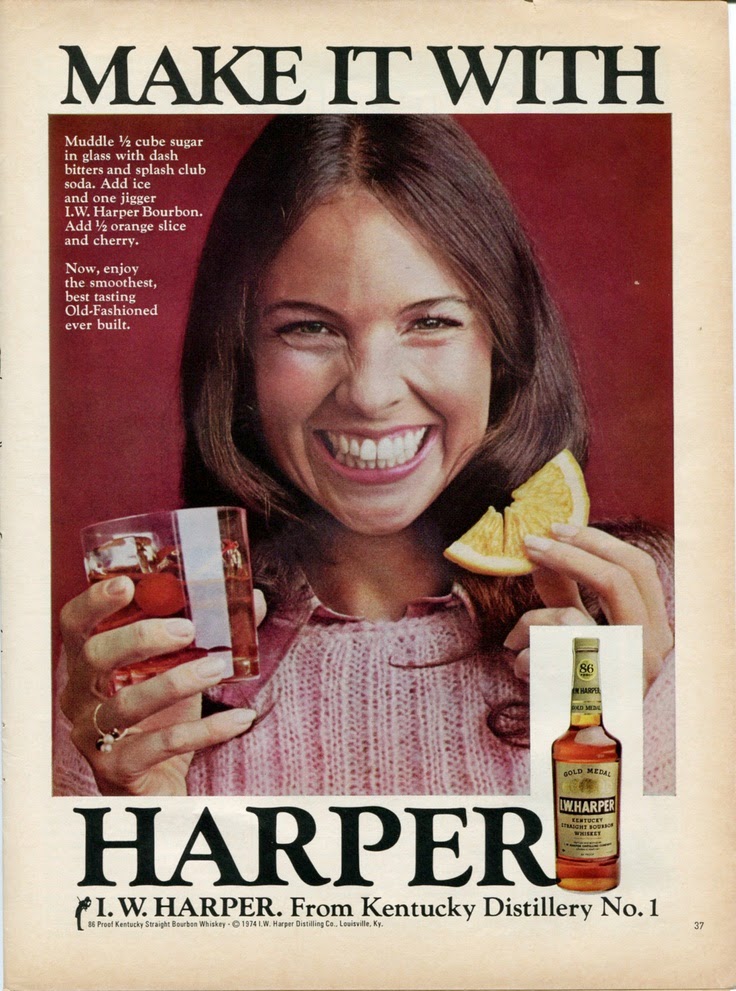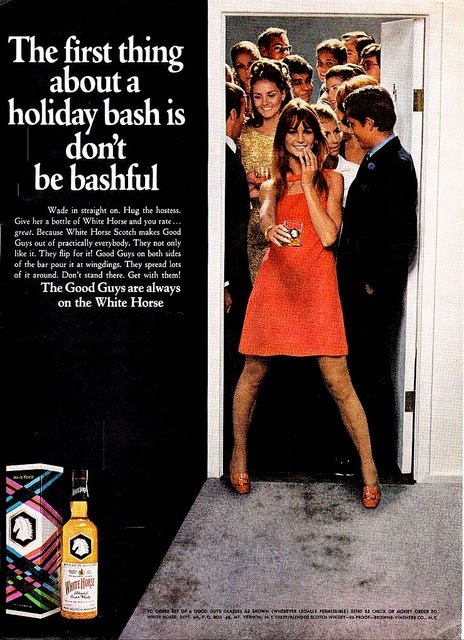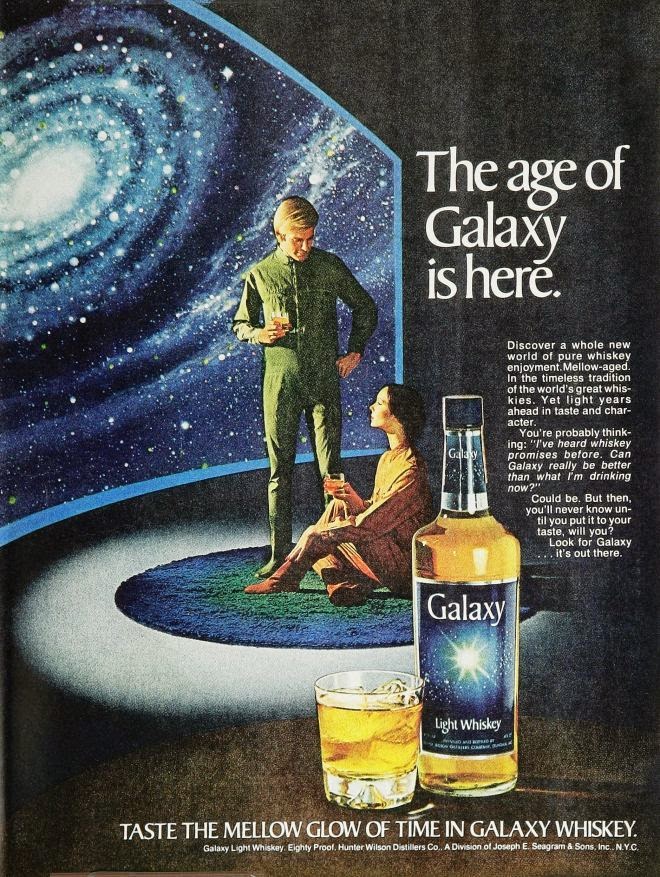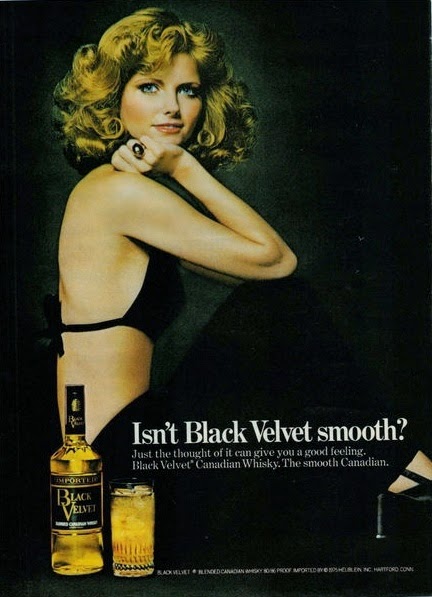19th Century part 1: Women as Goddesses and Nurturers
In the 19th century women in public art tended to be depicted as classical allegorical figures (i.e. women who represented an embodied ideal). As such women were depicted everywhere, often in classical dress (or nakedness) representing abstract ideas. For example we had women on coins (and the iconic Statue of Liberty) as Liberty herself. In front of the courthouse a woman wore a blindfold and held the scales of justice. Given the agricultural roots of whiskey production it should come as no surprise that some early whiskey labels depict a a female who evokes the classical representation of Ceres or Demeter, goddess of grain:
 |
| Bininger's Bourbon circa 1860 Library of Congress |
 |
| Roman Goddess Ceres 1852 |
 |
| Roman carving of Ceres - Goddess of Grain. |
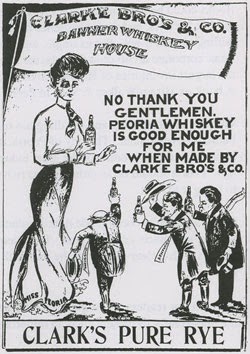 In the Clark's Pure Rye advertisement depicted at left the assembled drinkers hail a Gibson-girl dressed respectable woman who is labelled "Miss Peoria". She is an allegorical depiction of the city of Peoria, Illinois (the city where the popular brand "Clark's Pure Rye" was made in the 19th century up until Prohibition shut it down and ended Peoria's run as one of the biggest whiskey producing cities in the world. Another clue to her allegorical status is that, like the Statue of Liberty, she towers over the men.
In the Clark's Pure Rye advertisement depicted at left the assembled drinkers hail a Gibson-girl dressed respectable woman who is labelled "Miss Peoria". She is an allegorical depiction of the city of Peoria, Illinois (the city where the popular brand "Clark's Pure Rye" was made in the 19th century up until Prohibition shut it down and ended Peoria's run as one of the biggest whiskey producing cities in the world. Another clue to her allegorical status is that, like the Statue of Liberty, she towers over the men. Such allegorical depictions could be salacious too (and often were). Allegorical figures were often depicted in the nude - as the image of naked female bathers here in this ad for Old Sunny Brook (shows below). The nude bathers are depicted in a way that evokes the classical and Renaissance depictions of the 3 graces:
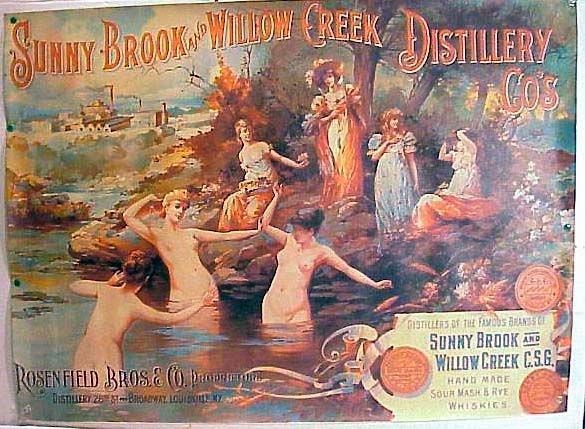
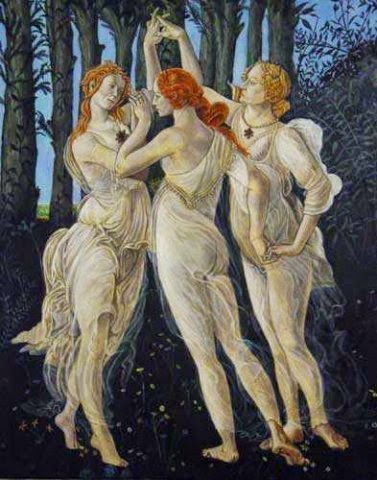

Other, more chaste depictions of women in the 19th century whiskey advertising centered on the perception of whiskey as medicinal and women as the mothering, nursing, care givers who administered whiskey as a domestic curative:
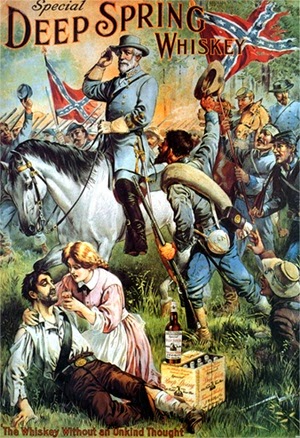
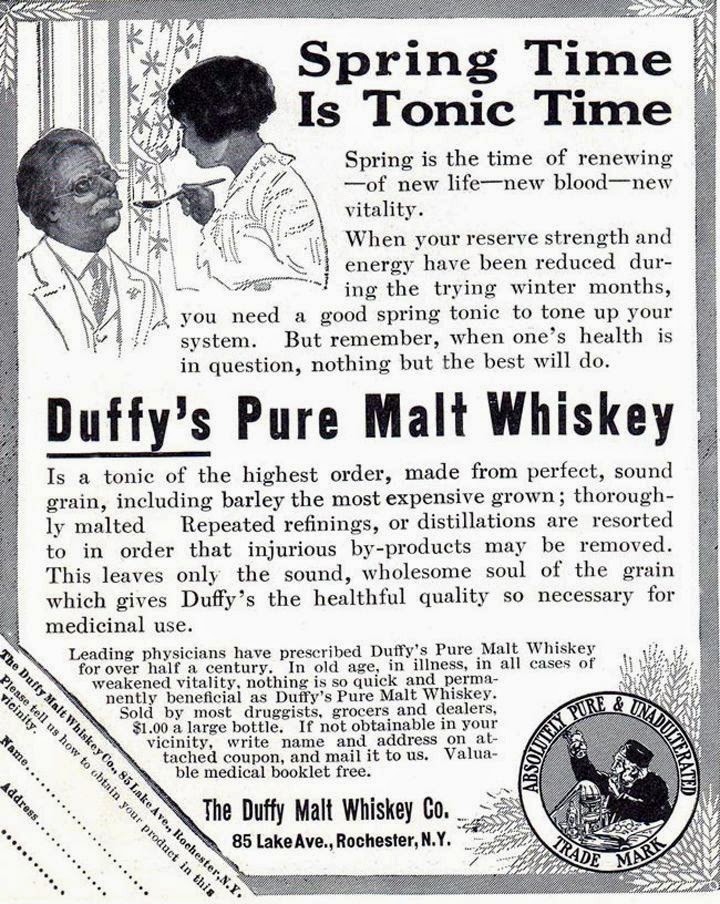
On the left, Mom administers Duffy's Pure Malt Whiskey as medicine to Grandpa. Duffy's was a famous case of snake-oil like lie-filled advertising. Malt whiskey was presented a nutritional powerhouse cure-all of disease. Food and drug legislation got its start in the outcry against such exaggerated claims. On the right, Deep Springs Whiskey makes a huge Confederate patriotic play. General Robert E. Lee salutes astride his famous white charger "Traveller" while being hailed by Grey-coat Confederate troops waving the stars and bars. In the foreground a field nurse administers a libation of Deep Springs Bourbon from a freshly opened case to a felled soldier with a bloody bandage on his leg. These depictions show women in the classic role of nurturing care giver.
19th Century part 2: The Saloon Culture of Prostitution
However, in a Madonna/Whore dichotomy, women were also depicted as sexually loose seductresses in 19th century whiskey advertising as well. As Fred Minnick makes clear in his masterful history of the subject, "Whiskey Women", a growing synergy between prostitution and whiskey drinking in the exploding saloon culture of the Wild West and later 19th Century culture of the East was becoming both culturally and economically ascendant:
"During the Gold Rush, taverns, brothels, and casinos popped up all over California, New Mexico, Colorado, and Wyoming, and they all employed women to “please” men and sell whiskey. In what Wild West historian Cy Martin called the “Great Whore Invasion” of 1850– 51, 3 California bar owners ordered prostitutes from Chile, China, Mexico, and France. More than 2,000 women arrived in San Francisco in 1850... Once they arrived at their employer, depending on the establishment, the women became waitresses to serve prospectors working the streams and mines with gold to burn. The average waitress/ prostitute earned $ 15 to $ 25 a week, but she also made a commission on selling whiskey. At San Francisco’s Bella Union, thirty “pretty waiter girls” worked in the upper and lower sections of the casino and encouraged men to buy liquor, while arousing them. The more they drank, the more she earned. One French prostitute earned $ 50,000 in a year, likely thanks to her ability to keep men drinking. Collectively , the income of these women probably exceeded many states’ gross revenue. ... In 1857 New York, sex-hungry men spent more than $ 7 million at brothels or “nearly as much as the annual municipal expenditure of New York City.” Visitors spent nearly as much on wine and liquor, $ 2.08 million, as they did on the prostitutes, $ 3.1 million. 5 The liquor and prostitution business rivaled any moneymaking venture of its time. If a tavern did not offer sexual services, it stood to lose customers."
Minnick, Fred (2013-10-01). Whiskey Women Potomac Books Inc..
Whiskey advertising of the period showed this aspect of the relationship between whiskey and women:
 |
| Old Crow Ad card depicting saloon show girls smoking - 1870. Library of Congress |
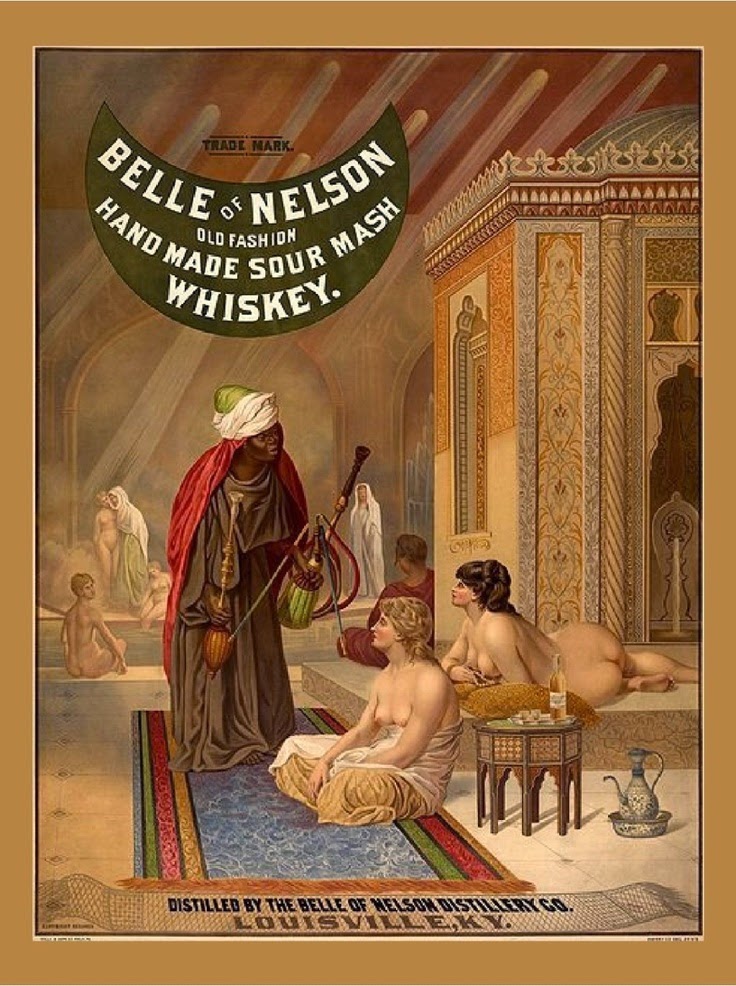 This ad (left) for Belle of Nelson Bourbon (1870s), depicts women in an oriental harem. Such depictions were extremely popular in the orientalist artistic traditions of the latter half of the 19th century. An example of a late 19th century orientalist painting by Hungarian popular artist Gyula Tornai is shown below. Such images represented an immoral sybaritic sexual free for all - code for the saloon brothel culture referenced by Fred Minnick in "Whiskey Women". However, by placing this in a cultural reference to a remote region referenced by art and literature it, like allegorical art, could bypass the prudish prohibitions against the exhibition of the female body and be acceptably publicly displayed.
This ad (left) for Belle of Nelson Bourbon (1870s), depicts women in an oriental harem. Such depictions were extremely popular in the orientalist artistic traditions of the latter half of the 19th century. An example of a late 19th century orientalist painting by Hungarian popular artist Gyula Tornai is shown below. Such images represented an immoral sybaritic sexual free for all - code for the saloon brothel culture referenced by Fred Minnick in "Whiskey Women". However, by placing this in a cultural reference to a remote region referenced by art and literature it, like allegorical art, could bypass the prudish prohibitions against the exhibition of the female body and be acceptably publicly displayed. |
| "In The Harem" - Gyula Tornai late 19th century |
 Evoking both the harem and the saloon bordello, this tin painted sign "A Nightcap of Wilson""'That's All'" (left) depicts two women partaking of shots of Wilson's Rye Whiskey (in the era before it became a blend). The standing figure is wearing a gauzy nightgown that makes it clear she is virtually naked. In the late 19th century the meaning of such a depiction would have been clearly sexual.
Evoking both the harem and the saloon bordello, this tin painted sign "A Nightcap of Wilson""'That's All'" (left) depicts two women partaking of shots of Wilson's Rye Whiskey (in the era before it became a blend). The standing figure is wearing a gauzy nightgown that makes it clear she is virtually naked. In the late 19th century the meaning of such a depiction would have been clearly sexual.The 1903 advertisement for Red Top Rye - a Kentucky rye distributed through Cincinnati OH (right across the Ohio River) shows a pair of free spirited women apparently dressed as Can Can dancers. Their wild spinning dance evokes the head spinning drunk of imbibing alcohol. Their red flowers, exposed legs and wild abandon clearly communicate the sexual abandon of the saloon culture as well:
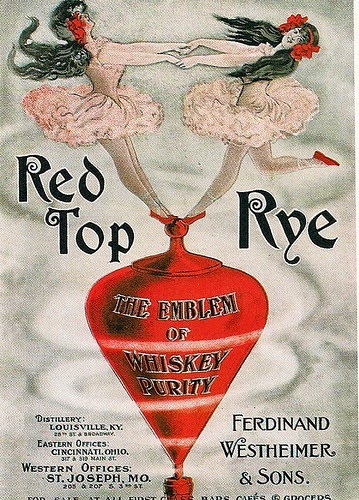
However the wild abandon of the saloon culture would become its undoing and would usher in the cultural backlash that culminated in Prohibition. Fred Minnick, in "Whiskey Women" describes this movement thus:
"... towns across the country were filled with wives losing husbands to liquor and brothels. The country’s mood toward the saloon became a “social evil” where wild women forced men into intoxication and adultery. ... it was much easier for society to blame the women, often forced sex slaves, and the whiskey than to hold the men accountable for their actions. When answering to their wives for their infidelity , the men would say, “The whiskey made me do it.” This growing concern led to cities cracking down on prostitution and passing prohibitive liquor laws. In 1892 time, it was much easier for society to blame the women, often forced sex slaves, and the whiskey than to hold the men accountable for their actions. When answering to their wives for their infidelity , the men would say, “The whiskey made me do it.” This growing concern led to cities cracking down on prostitution and passing prohibitive liquor laws. In 1892 the San Francisco City Council passed a law prohibiting liquor sales in theaters, effectively destroying Bella Union’s ability to attract clientele . Newspapers ran front-page editorials, calling prostitution a “parent of evil . It is not only a social evil, it is a sanitary evil, and is even becoming a political evil.”
"The best governmental fight against prostitution was temperance. Stopping the saloons and the ladies of the night became the battle cry for the temperance movement. It was also a marketing point for the suffrage movement, with the Woman’s Journal calling woman suffrage a cure for prostitution."
Minnick, Fred (2013-10-01). Whiskey Women (p. 61). Potomac Books Inc.. Kindle Edition.
Repeal - Women As Evidence of Class, Not Objects of Sex
In the aftermath of Prohibition, advertisers were careful to steer clear of any representation of sexuality. Women generally hardly appear on any adverting for whiskey from Repeal until the advent of the sexual revolution in the early 1960s. Men are depicted drinking, either alone or in clubby groups. The few exceptions show women as chaste respectable companions in party or dinner environs that emphasize high class and good manners. View a large gallery of ads from the Repeal era through WWII and see how many men appear on ads vs women during this period.
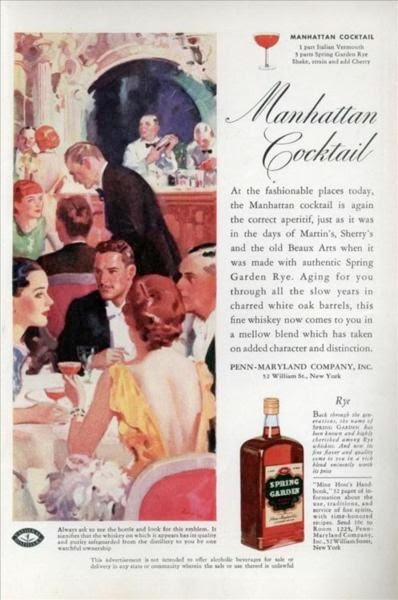 The classy Manhattan cocktail - as presented in this National Distiller's advertisement of 1934, the year immediately following Repeal: "At the fashionable places today, the Manhattan cocktail is again the correct apertif, just as it was in the days of Martin's Sherry's, and the old Beaux Arts when it was made with authentic Spring Garden Rye. Aging for you through all the slow years in charred white oak barrels, this fine whiskey now comes to you in a mellow blend which has taken on added character and distinction. Penn-Maryland Company, Inc. William Street, New York"
The classy Manhattan cocktail - as presented in this National Distiller's advertisement of 1934, the year immediately following Repeal: "At the fashionable places today, the Manhattan cocktail is again the correct apertif, just as it was in the days of Martin's Sherry's, and the old Beaux Arts when it was made with authentic Spring Garden Rye. Aging for you through all the slow years in charred white oak barrels, this fine whiskey now comes to you in a mellow blend which has taken on added character and distinction. Penn-Maryland Company, Inc. William Street, New York"The women are shown as classy accompaniment for the handsome well dressed men. This is also the case in the 1930 English ad for Dewar's White Label shown below. The tag line hints give us their conversation - turgid and snobby as it is, given their extreme high class and well-dressed for dinner-ness (white tie for him).
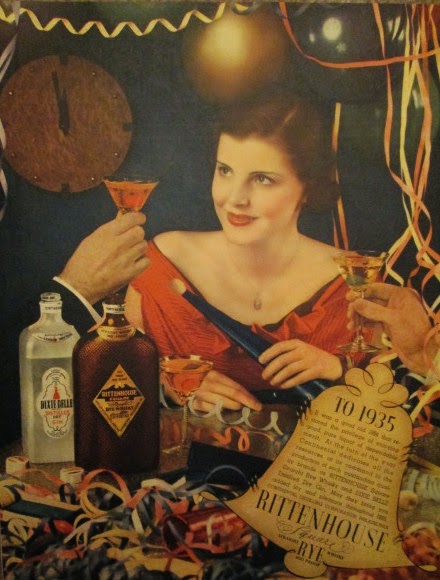
The pair of ads for Rittenhouse Rye directly above date from late 1934- the year the brand was introduced (along with Dixe Belle Gin) by Continental Distilling. On the left we see a nostalgic theme of a 19th century sleigh. Uniquely the woman is seen as holding the reins and doing the driving. This is the first time a woman is the primary actor in a whiskey ad that is neither allegorical or salacious. On the right three people ring in the new year 1935 at the stroke of midnight. Two men are disembodied hands. The self possessed woman in the middle of the image is in control - feted by multiple men she presumably gets to choose between. It seems likely that these ads were aimed at women.
The 1950s Fleischmann's Blended Whiskey Campaign: Early Signs of a Coming Sexual Thaw.
In a foreshadowing of the sexual revolution, a rare appearance by women in whiskey ads during this period (outside of populating party pictures or holding a serving tray) is in this famous late 1950s campaign. In each ad a man carries an enormous bottle of cheap Fleischmann's blended whiskey home and elicits appreciative delighted glances and attention from pretty, well dressed (i.e. high status), ladies on the street. Presumably they can't resist the inherent humor of the big bottles. The barely hidden subliminal subtext is that he is hugely endowed with a titanic erect phallus which is what garners the female attention. The women here are to provide the approving gaze - within a subliminal sexual context. That edge of sexuality was new - and about to become a tidal wave. But the women in these transitional ads are chastely fully dressed and at a physical distance.
The 60s and 70s: rise of the Feminist Movement and the Sexual Revolution.
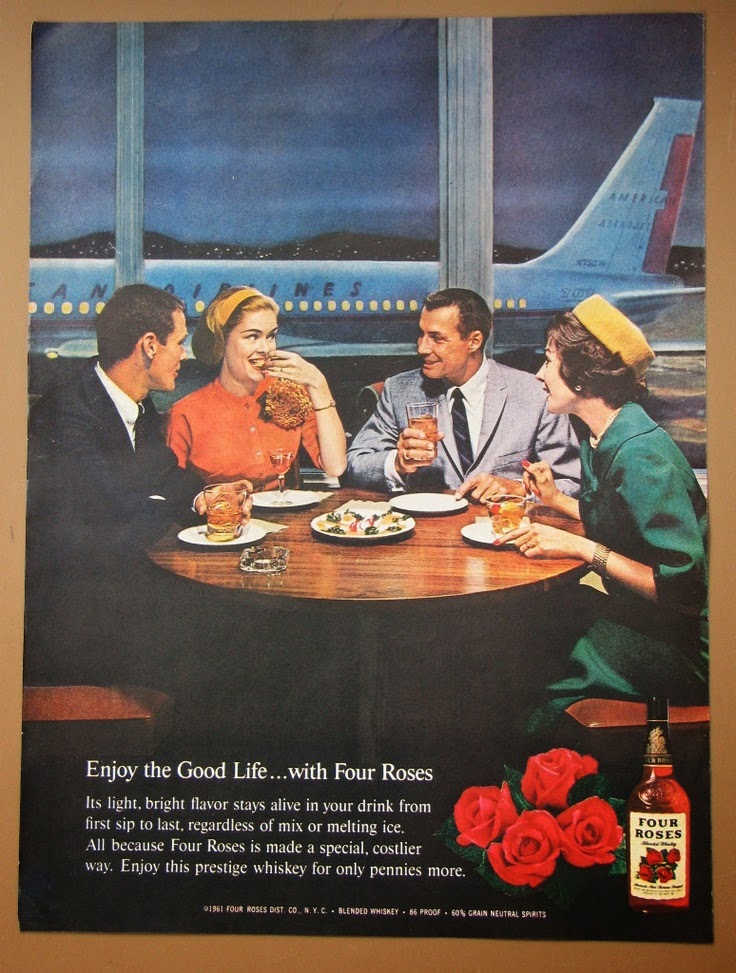 The 60s begin with much of the flavor and style of the 1950s but this 1960 Four Roses advertisement shows something new. At first glance it looks a lot like the Repeal era ads showing men and women at a table having whiskey in a way that emphasizes class. And there is some of that going on here too - they are at an airport, about to go jet setting across the globe which was still a new, glamorous, and classy thing to be doing in 1960. But look at their faces and body English. These people are flirting. The obvious prelude to sexual activity seen in the blonde's open mouth and the clear attention that this draws from the three other people in the scene is completely new in whiskey advertising. It will become, as we will see below - completely dominating almost right away.
The 60s begin with much of the flavor and style of the 1950s but this 1960 Four Roses advertisement shows something new. At first glance it looks a lot like the Repeal era ads showing men and women at a table having whiskey in a way that emphasizes class. And there is some of that going on here too - they are at an airport, about to go jet setting across the globe which was still a new, glamorous, and classy thing to be doing in 1960. But look at their faces and body English. These people are flirting. The obvious prelude to sexual activity seen in the blonde's open mouth and the clear attention that this draws from the three other people in the scene is completely new in whiskey advertising. It will become, as we will see below - completely dominating almost right away. 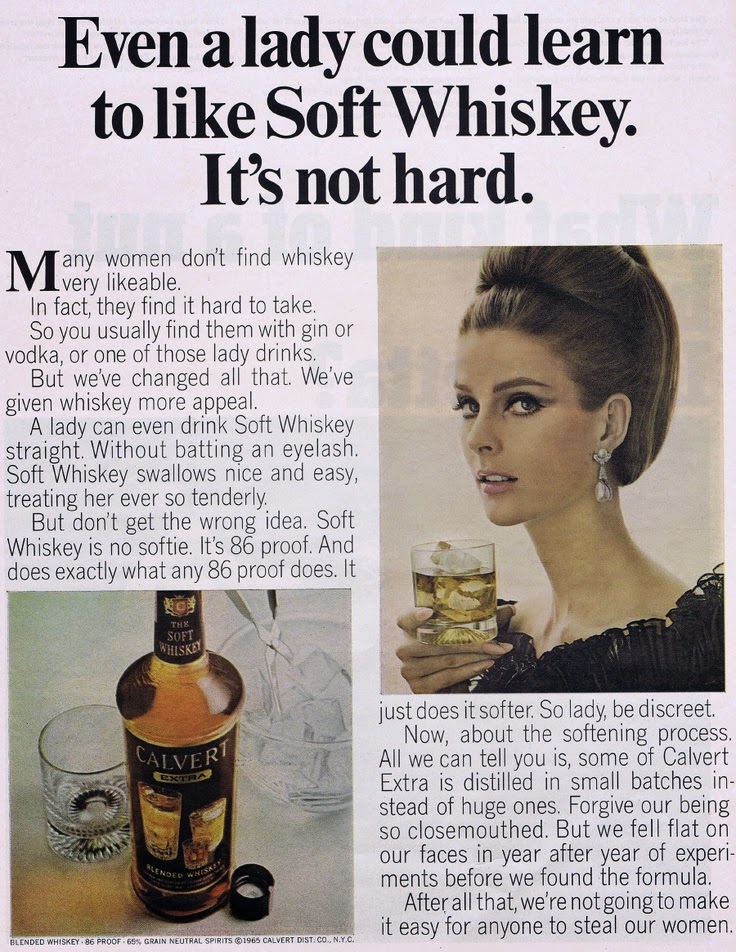 This 1965 Calvert Canadian Whiskey ad shows the ancient and enduring cultural gender bias about whiskey: that whiskey is for men because it's "too hard" for women. This is the manifesto of doom to the whiskey industry that an empowered woman-centric market implies. Feminine women, the thinking goes, don't like whiskey because it's mannish. They prefer softer fruiter white spirits fare. But feminist empowered women, thus, should love whiskey because they embrace the mannish attributes of being empowered. But, of course, this ad isn't about empowered feminist women. It's about the lovely long stemmed "lady" you, as a Mad-Men era man, want to bed. Even this kind of lady will drink this particular whiskey, the ad argues, because it's so soft - the essential feminine attribute. The main point being that she's drinking - that's good because YOU, the reader of the ad (a man) want to get her drunk to take advantage of her sexually. The text reads: "Many women don't find whiskey very likable. In fact they find it hard to take. So you usually find them with gin or vodka, or one of those lady drinks. But we've changed all that. We've given whiskey more appeal. A lady can even drink Soft Whiskey straight. Without batting an eyelash. Soft Whiskey swallows nice and easy, treating her ever so tenderly. But don't get the wrong idea. Soft Whiskey is no softie. It's 86 proof. And does exactly what any 86 proof does. It just does it softer...."(and what it does is lower her inhibitions - i.e. get her inebriated - right?).
This 1965 Calvert Canadian Whiskey ad shows the ancient and enduring cultural gender bias about whiskey: that whiskey is for men because it's "too hard" for women. This is the manifesto of doom to the whiskey industry that an empowered woman-centric market implies. Feminine women, the thinking goes, don't like whiskey because it's mannish. They prefer softer fruiter white spirits fare. But feminist empowered women, thus, should love whiskey because they embrace the mannish attributes of being empowered. But, of course, this ad isn't about empowered feminist women. It's about the lovely long stemmed "lady" you, as a Mad-Men era man, want to bed. Even this kind of lady will drink this particular whiskey, the ad argues, because it's so soft - the essential feminine attribute. The main point being that she's drinking - that's good because YOU, the reader of the ad (a man) want to get her drunk to take advantage of her sexually. The text reads: "Many women don't find whiskey very likable. In fact they find it hard to take. So you usually find them with gin or vodka, or one of those lady drinks. But we've changed all that. We've given whiskey more appeal. A lady can even drink Soft Whiskey straight. Without batting an eyelash. Soft Whiskey swallows nice and easy, treating her ever so tenderly. But don't get the wrong idea. Soft Whiskey is no softie. It's 86 proof. And does exactly what any 86 proof does. It just does it softer...."(and what it does is lower her inhibitions - i.e. get her inebriated - right?).This ad explicitly states the attitude about whiskey that brought about the massive decline in whiskey consumption in the from the 70s through the 90s. If whiskey is harsh and women prefer "lady drinks", vodka and gin, then as a considerate man reading this ad I would reasonably conclude that rather than try to get her to drink some half-@$$'ed "Soft Whiskey" I should just stock up on vodka and gin and fixings for "lady drinks". And, you know what? That's exactly what America did - dropping whiskey like a hot potato for decades.
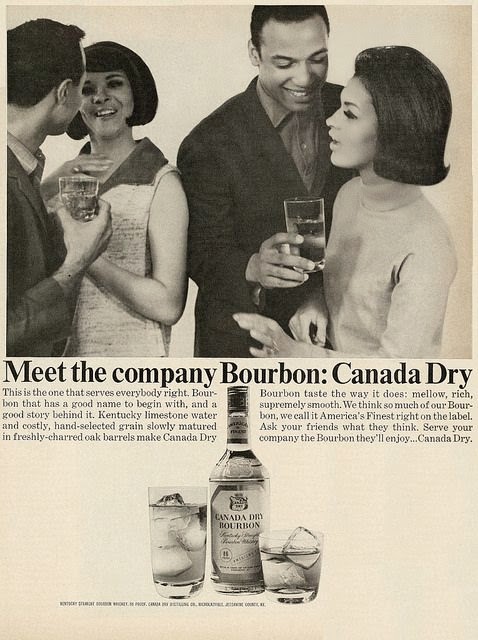 This Canada Dry Bourbon advertisement from 1965 shows the sexual context that whiskey was trying to position itself in (whiskey as social lubricant and prelude to sex). It adds the very modern wrinkle of showing couples of mixed race. This gives it a progressive Civil Rights feel. Sadly for Canada Dry Bourbon their product was atrocious and disappeared from the market shortly thereafter - the subject of a recent blog post here on The Tot.
This Canada Dry Bourbon advertisement from 1965 shows the sexual context that whiskey was trying to position itself in (whiskey as social lubricant and prelude to sex). It adds the very modern wrinkle of showing couples of mixed race. This gives it a progressive Civil Rights feel. Sadly for Canada Dry Bourbon their product was atrocious and disappeared from the market shortly thereafter - the subject of a recent blog post here on The Tot. Late 1960s-Early 70s - White Horse Pretends To Be Feminist to Get Men Laid. But Empowered Women Might Not Be Whiskey Drinkers.
 Old White Horse was some very good drinking back in the 70s and prior with its old-school flavors of Lagavulin and honeyed highland blended in. But in the late 60s and early 70s White Horse was losing sales volume - like most other whisky brands - and was struggling to stay relevant. Clearly the rise of the women's liberation movement and the sexual revolution was the right topic to make whisky seem young and hip again, right? In this ad we learn that "Today, the one who wears the pants chooses the Scotch". "Comes the 'look-alike' generation - they dress alike, work alike, play alike. Now meet the Scotch they like alike: White Horse..." The message is clear: women are empowered. See? She's wearing pants - and that connects the cliche about "who wears the pants in the family?" You can see her power is ascendant over his because her legs are open in a power posture. Her hips cocked in a sassy angle emphasize her sexual control. Meanwhile, the man's are crossed in an emasculated way. She's driving things here. The ad copy says that she likes Scotch - presumably because Feminism has made her a clone of the man and HE likes Scotch. But that was wishful thinking. The fact was that she actually was driving those drinking decisions and she had her own ideas. Indeed, she was increasingly choosing vodka with fruit juice - white rum, gin, and tequila - preferably with lime.
Old White Horse was some very good drinking back in the 70s and prior with its old-school flavors of Lagavulin and honeyed highland blended in. But in the late 60s and early 70s White Horse was losing sales volume - like most other whisky brands - and was struggling to stay relevant. Clearly the rise of the women's liberation movement and the sexual revolution was the right topic to make whisky seem young and hip again, right? In this ad we learn that "Today, the one who wears the pants chooses the Scotch". "Comes the 'look-alike' generation - they dress alike, work alike, play alike. Now meet the Scotch they like alike: White Horse..." The message is clear: women are empowered. See? She's wearing pants - and that connects the cliche about "who wears the pants in the family?" You can see her power is ascendant over his because her legs are open in a power posture. Her hips cocked in a sassy angle emphasize her sexual control. Meanwhile, the man's are crossed in an emasculated way. She's driving things here. The ad copy says that she likes Scotch - presumably because Feminism has made her a clone of the man and HE likes Scotch. But that was wishful thinking. The fact was that she actually was driving those drinking decisions and she had her own ideas. Indeed, she was increasingly choosing vodka with fruit juice - white rum, gin, and tequila - preferably with lime.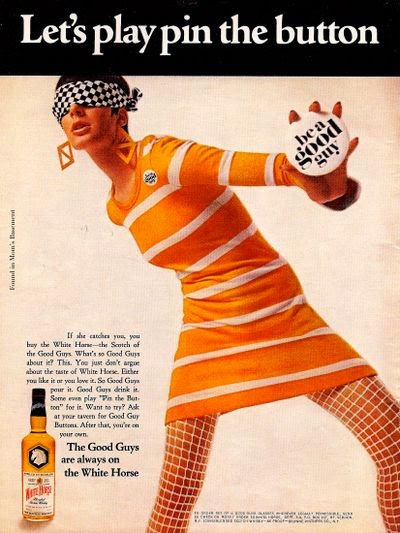
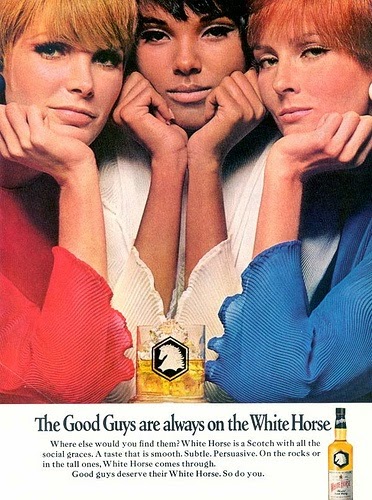
Empowered feminist women are shown in these ads. To the left we see a woman dressed in state-of-the-art Go Go mod clothes literally blindfolded looking for "the good guy". The ads all say "The Good Guys are always on the White Horse". It was meant to evoke an amusing party game but clearly represented the search for a mate. She is doing the choosing. The fact that the button she is using to "pin the tail on the donkey" is the slogan "be a good guy" implies that only through fulfilling her wants can you (the man) be sexually worthy of being selected. This is the opposite of "The Imp" ad above where she docilely sips the drink the man gave her. Here she is actively (if blindly) searching for Mr. Goodbar to give her what she wants. The ad is telling you it's Scotch but you might choose to be more empirical about it. The tough women on the right are ganged up against you, the hapless male, telling you that if you want to make it with them you better be one of "the Good Guys". But the clear modernity of these women dictates the rejection of an old traditional brand of Scotch like White Horse. Secretly you know you had better bring her a Cosmo, Sex on the Beach, or a Margarita, right? In any case - the point is obvious. These women are the ones in control.
More White Horse advertising goodness. On the left we have a young Ali McGraw as part of the crew of women who will judge you harshly if you show up "alone" (i.e. not bearing a bottle of White Horse). Meanwhile, just look a these women. They aren't Scotch drinkers. Who are they kidding? Ditto on the right. This bandy legged fox in the hot red dress wants something. The ad's text says "Wade in straight on. Hug the hostess. Give her a bottle of White Horse and you rate..." It's the same misplaced message attached to an image of the kind of woman you desperately want to sleep with but deep down you know is doing tequila shots. Notice that she's forcefully filling the doorway. The man attending her is sideways, almost invisible.
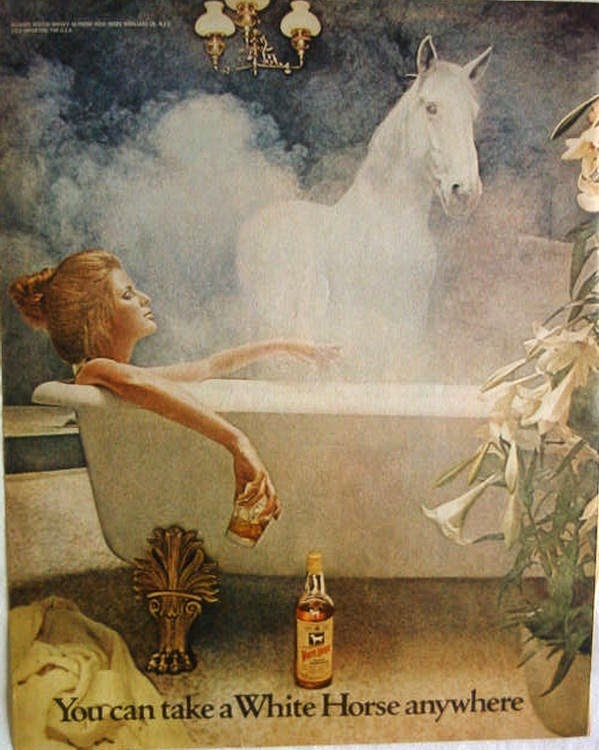 By the early 70s we have a return to the White Horse - the actual animal - crashing the party (a staple of the advertising of the 50s). But here the party is the babe naked in the tub. The ad might be talking to "you" again (i.e. the male whisky buyer). You can take that White Horse anywhere - i.e. into the tub with that woman. The White Horse is the symbol of male sexual power after all. But this white horse looks like a unicorn and the woman in the image is supremely self possessed and independent. The white lilies symbolize chastity and virtue - the sign of the Virgin Mary's annunciation. This is a feminist ad aimed at the empowered woman herself. It seeks to equate having a Scotch with blissful, almost spiritual, hedonistic retreat.
By the early 70s we have a return to the White Horse - the actual animal - crashing the party (a staple of the advertising of the 50s). But here the party is the babe naked in the tub. The ad might be talking to "you" again (i.e. the male whisky buyer). You can take that White Horse anywhere - i.e. into the tub with that woman. The White Horse is the symbol of male sexual power after all. But this white horse looks like a unicorn and the woman in the image is supremely self possessed and independent. The white lilies symbolize chastity and virtue - the sign of the Virgin Mary's annunciation. This is a feminist ad aimed at the empowered woman herself. It seeks to equate having a Scotch with blissful, almost spiritual, hedonistic retreat. But, as it turned out in the end, she didn't really want that old Scotch anyway. Yes - White Horse, too, has become a bottom of the shelf cheap blend. All these advertising dollars couldn't stop the juggernaut of changing tastes and the rise of cocktail culture.
Does Being Feminist Mean Drinking Like a Man?
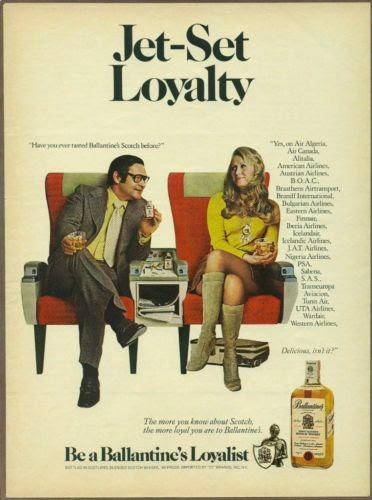 White Horse wasn't the only brand pretending that empowered newly feminist women would mirror the traditional male alcohol preference for Scotch whisky. Ballantine's did it too. On the left we have the guy asking if she's ever tasted Ballantine's before. She answers with an extensive dossier of experience - many more than he has. She has full mastery of the situation - and rears up taller than him. Her depth of experience is a sign that she has beat him at his own male game of being all about Scotch. Ballantines was hoping that empowered women would choose the same reward as men did (Scotch whisky). It was wishful thinking and it was out of touch.
White Horse wasn't the only brand pretending that empowered newly feminist women would mirror the traditional male alcohol preference for Scotch whisky. Ballantine's did it too. On the left we have the guy asking if she's ever tasted Ballantine's before. She answers with an extensive dossier of experience - many more than he has. She has full mastery of the situation - and rears up taller than him. Her depth of experience is a sign that she has beat him at his own male game of being all about Scotch. Ballantines was hoping that empowered women would choose the same reward as men did (Scotch whisky). It was wishful thinking and it was out of touch.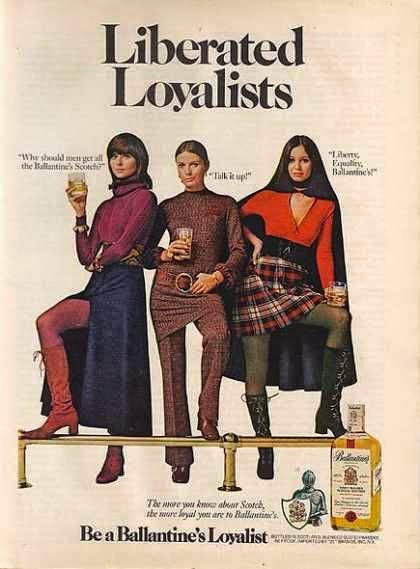 This ad (right) is even more overtly pseudo-feminist. These women are "Liberated" as the ad copy explicitly says. The one on the left asks "Why should men get all the Ballantine's Scotch?" This is the outright statement of the whole line of thought: 'if women are empowered; then they have become men. And men drink Scotch. Thus liberated women drink Scotch too.'
This ad (right) is even more overtly pseudo-feminist. These women are "Liberated" as the ad copy explicitly says. The one on the left asks "Why should men get all the Ballantine's Scotch?" This is the outright statement of the whole line of thought: 'if women are empowered; then they have become men. And men drink Scotch. Thus liberated women drink Scotch too.'The middle one says "Talk it up". The one on the right says "Liberty. Equality. Ballentines". i.e. be feminist and liberated by being a brand loyal Scotch drinker like a man. This ad is aimed at women and attempted to shoehorn them into the view that empowered means 'Scotch drinking'.
But feminism had empowered women and allowed them to have to upper hand in the mating narrative and also in the drinks selection. Now, with the hindsight of history we know what happened. Whisky bit the dust for a whole generation.
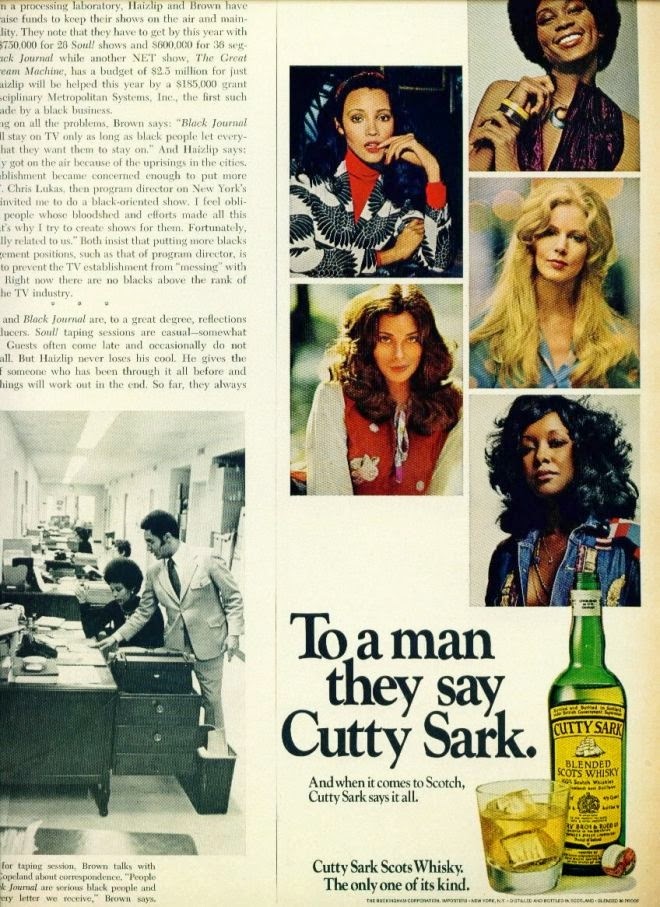 These empowered women speak in this 1970 Cutty Sark ad. "To a man they say Cutty Sark". If this ad is read by a woman the story is that 'as a man, you'll choose to drink Scotch'. I.e. if you're an empowered feminist you will be mannish and will have to pick a man's drink. Of, if read by a man that the newly empowered women wants a man to buy them old fashioned white man whisky. That, obviously feminism is some kind of a sham and men still need to be the ones to bring the whisky - 'and you ARE a man, aren't you?' "To a man" - i.e. when speaking to you - the man - the potential sexual partner - they tell YOU they want that whiskey. I.e. you should buy it. Except, of course, they (these women of 1970 demographically) didn't actually want whisky at all. As the Calvert ad told us years before "Many women don't find whiskey very likable. In fact they find it hard to take. So you usually find them with gin or vodka, or one of those lady drinks."
These empowered women speak in this 1970 Cutty Sark ad. "To a man they say Cutty Sark". If this ad is read by a woman the story is that 'as a man, you'll choose to drink Scotch'. I.e. if you're an empowered feminist you will be mannish and will have to pick a man's drink. Of, if read by a man that the newly empowered women wants a man to buy them old fashioned white man whisky. That, obviously feminism is some kind of a sham and men still need to be the ones to bring the whisky - 'and you ARE a man, aren't you?' "To a man" - i.e. when speaking to you - the man - the potential sexual partner - they tell YOU they want that whiskey. I.e. you should buy it. Except, of course, they (these women of 1970 demographically) didn't actually want whisky at all. As the Calvert ad told us years before "Many women don't find whiskey very likable. In fact they find it hard to take. So you usually find them with gin or vodka, or one of those lady drinks."All of these women's liberation period whisky ads reek of the stink of failure. The whisky industry attempted to equate feminine power with the masculine choice of drinking brown but it didn't work at all. Women led the charge towards white spirits and utterly crushed the whisky industry... like a bug.
But this inversion of sexual power dynamics didn't last for long.
(Update - these last two sections have been re-written to incorporate the perceptive analysis Susanna Skiver Barton provided in the comments. Thanks to Susanna for taking the time to engage.)
The 80s through today - Women As Sexual Prizes To Be Won. And finally just disposable faceless aspects of male self-affirmation.
Male sexual power in whiskey advertising quickly played the anti-feminist trump card: objectification. A barrage of ads quickly surfaced that just showed beautiful women adorning the product. The most famous example of this aesthetic were the Black Velvet ads of the late 70s and early 80s:
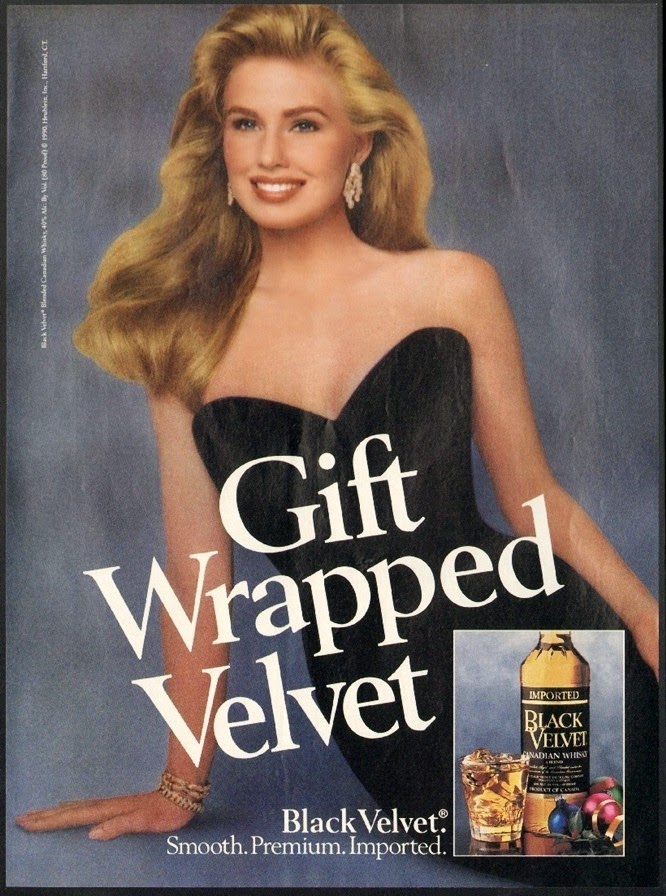 Cherlyl Tiegs' iconic 1975 Black Velvet ad really set the tone. She sizzled in a dress that was more not there than there. By 1980 we have amped the sexuality with text that conflates "touch" with drinking the whisky. By 1990 we now have text which makes it explicit that the dress is be taken off: But, ultimately, as objectification of women go, these ads are fairly tame. The women appear classy and beautiful - self possessed and composed. They don't have a thing to do with the whisky, but at least they appear to be in charge of their own destinies.
Cherlyl Tiegs' iconic 1975 Black Velvet ad really set the tone. She sizzled in a dress that was more not there than there. By 1980 we have amped the sexuality with text that conflates "touch" with drinking the whisky. By 1990 we now have text which makes it explicit that the dress is be taken off: But, ultimately, as objectification of women go, these ads are fairly tame. The women appear classy and beautiful - self possessed and composed. They don't have a thing to do with the whisky, but at least they appear to be in charge of their own destinies. As we saw last week, in the world of advertising aimed at black men, men clearly have the dominant position. This 1977 Canadian Club ad makes it clear that the man is in charge. The text is explicit: "The CC man is back. He's young. He's confident. He's looking good. Drinking good. Canadian Club Whisky. Look who's drinking Canadian Club now". She isn't even mentioned. The woman's approval is like jewelry for the man: an attractive attribute of him. She has no autonomous reality at all. She is in full retreat into the background while he focuses fully on his whisky. His focus is squarely away from her. It's all about him.
Into the late 1990s we get the Evan Williams "the longer you wait the better it gets" ads. The point here is that ... ahem... whiskey gets better with some maturation. By 100% conflating sexually hot women with the whiskey these ads take whiskey advertising where the Black Velvet ads only hinted. You could still imagine that the Black Velvet babes maybe just drank the stuff. Now, Evan Williams tells you clearly that the babes ARE the stuff. The before and after images of women here imply a history - but that's not the point. The point is that they have become sexually awesome with some "time in the barrel" - just like the whiskey. You aren't meant to consider them as human beings; solely as objects of desire and then associate that feeling with the whiskey. We are squarely back in the oriental harem here in terms of gender dynamics.
 In an odd way it's like a full circle. The Evan Williams beauties are like allegorical figures - beautiful embodiment of the whiskey itself like the farm girl reaper of 1860 was the embodiment of Ceres - goddess of grain. But it's just another step away from women being depicted as real people. It, thus, wouldn't be long until we dispense with any shred of personhood for the woman at all. With this late 2000s ad campaign from Jim Beam we have faceless tight cropped image of female sexuality posing with the whiskey. Sexuality accents the product like it would in a fashion ad.
In an odd way it's like a full circle. The Evan Williams beauties are like allegorical figures - beautiful embodiment of the whiskey itself like the farm girl reaper of 1860 was the embodiment of Ceres - goddess of grain. But it's just another step away from women being depicted as real people. It, thus, wouldn't be long until we dispense with any shred of personhood for the woman at all. With this late 2000s ad campaign from Jim Beam we have faceless tight cropped image of female sexuality posing with the whiskey. Sexuality accents the product like it would in a fashion ad.A fashion ad? Yes - like this notorious Dolce & Gabbana pseudo rape ad. It's all about male power and the woman is a silent victim - robbed even of her power to shock or evoke pity because she so damned fashionable and immaculately put together. Male power is hot and female submission is a style decision - like whether to wear leather.
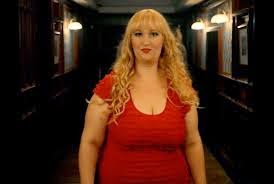 In this cultural environment it's not hard to see how we might end up in a situation where a whole ad campaign could be envisioned where whisky is a lifestyle accessory for men who completely objectify women; treating them as conquests and obsticles. Indeed, on a recent Dewar's spot... on a dark road late at night with our handsome blond male protagonist being saved by the dark haired Baron. Then ending up in a bar where this lady (on the right in the red dress) comes walking up:
In this cultural environment it's not hard to see how we might end up in a situation where a whole ad campaign could be envisioned where whisky is a lifestyle accessory for men who completely objectify women; treating them as conquests and obsticles. Indeed, on a recent Dewar's spot... on a dark road late at night with our handsome blond male protagonist being saved by the dark haired Baron. Then ending up in a bar where this lady (on the right in the red dress) comes walking up:Oh NO! It's an overweight, and thus horribly unattractive woman! She is clearly not at all a part of the century long narrative of female beauty so carefully constructed over decades. That's unacceptable! Who will save our poor male protagonist now?
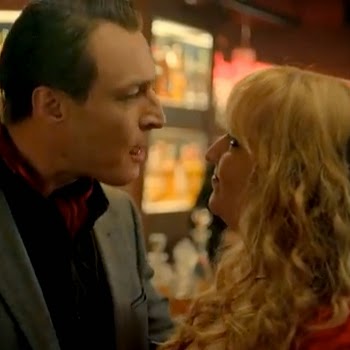 Oh, yay! It's the Baron! Here he has diverted the overweight woman away from our protagonist; "falling on the grenade" in the parlance. This grotesque: the cruelty to depict the potential affections of a an otherwise attractive person who who happens to be overweight is what drove this ad over the line as politically incorrect discrimination.
Oh, yay! It's the Baron! Here he has diverted the overweight woman away from our protagonist; "falling on the grenade" in the parlance. This grotesque: the cruelty to depict the potential affections of a an otherwise attractive person who who happens to be overweight is what drove this ad over the line as politically incorrect discrimination. The controversy over this spot was well documented on Grub Street:
http://www.grubstreet.com/2013/12/dewars-meet-the-baron-ad.html
And, perhaps, even better on Malt Maniac Oliver Klimek's blog Dramming:
http://www.dramming.com/2013/12/11/baron-dewar-crash-landing-of-a-glasgow-superhero/
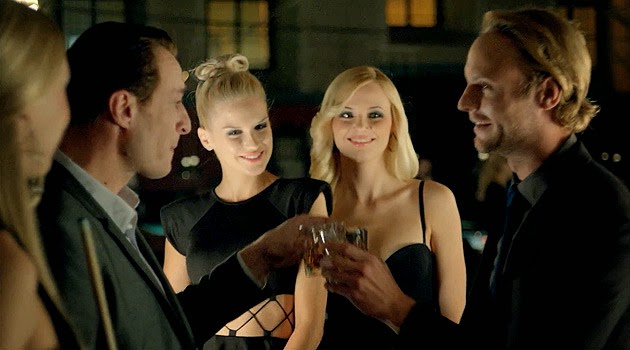
Later we get to see that the Baron and the protagonist share the reward: a date with the "Swedish bikini team" of ultra-hot blondes.
The whole campaign is "hosted" by the lingerie and fur clad woman you see at right. In a series of object lessons (the spots), this lingerie-clad hottie is going to teach you to be a real man. Hint: it involves disrespecting women and embracing some very antique notions of behavior. That socialization lesson is underscored by fashion and facial hair cues taken from the Victorian period. (For more on this pulled campaign read this fawning piece: http://www.theruggedmale.com/dewars-the-drinking-mans-scotch-claire-forlani/).
Now, thanks to Johanne McInnis (The Whisky Lassie) that particularly offensive ad campaign from Dewars was pulled - but that it was even produced and then released shows that our Zeitgeist is at least partially here: Feminism took whiskey away; whiskey's return means feminism's negation. Women in this ad campaign have no autonomous reality. They are just affirmation for the men in these ads. Meanwhile, in the real world, women are becoming an important market for whiskey. Yet, much of the whiskey marketing feels like it's giving life lessons to sadly clueless men. Significantly, women in these recent ads are not about - as they were in the 30s-50s - class, or - as they were in the 60s-70s - immediate sex potential. Now they have become accessories to male empowerment. The point here isn't that women will have sex with you if you give them whisky. It's that women will let you be in the dominant position - as if the women's movement of the 60s and 70s had never happened. Whiskey is presented as a cultural vestige of a time before feminism - and a magical way to transport you there.
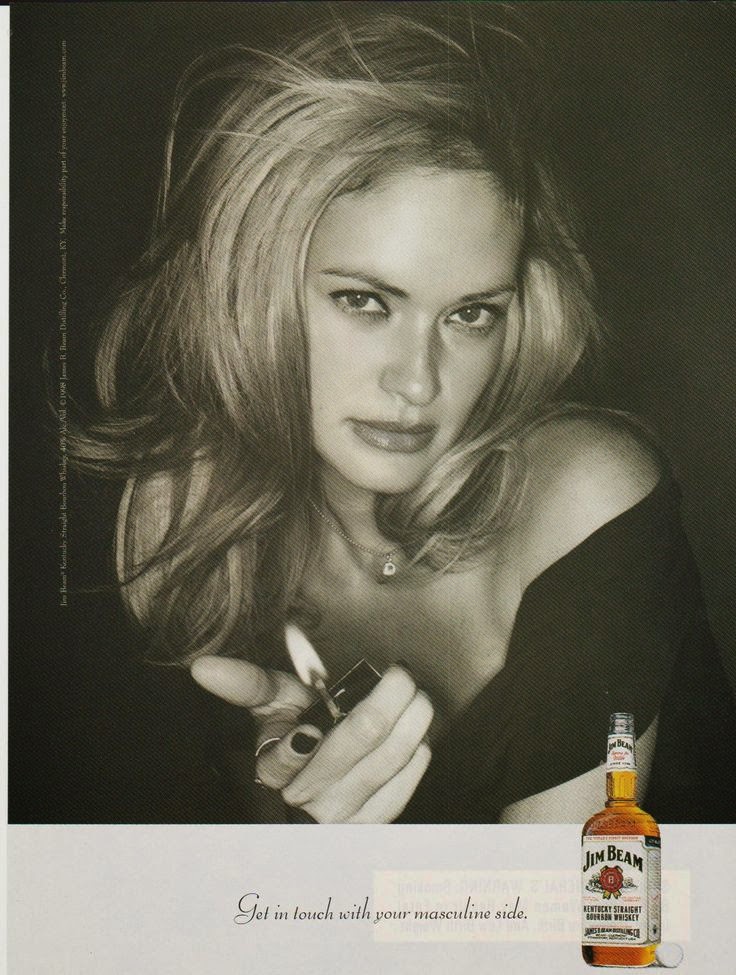 We end with this 1998 Jim Beam ad: "Get In Touch With Your Masculine Side". I.e., as a man, connect with lust, objectify women, and drink your Bourbon as if feminism had never happened. Viewed from a woman's perspective, drinking Bourbon is being like a man. I.e. a woman drinking Bourbon is like a woman wearing a man's shirt or his underwear. Sexy cross-gender dress up. Bottom line, whisky is still depicted as utterly male. A woman drinking it is surrendering her sex and choosing to subjugate herself to maleness.
We end with this 1998 Jim Beam ad: "Get In Touch With Your Masculine Side". I.e., as a man, connect with lust, objectify women, and drink your Bourbon as if feminism had never happened. Viewed from a woman's perspective, drinking Bourbon is being like a man. I.e. a woman drinking Bourbon is like a woman wearing a man's shirt or his underwear. Sexy cross-gender dress up. Bottom line, whisky is still depicted as utterly male. A woman drinking it is surrendering her sex and choosing to subjugate herself to maleness. Socially, "we've come a long way, Baby" but we still have far to go when it comes to depicting women in a mature way in whiskey advertising. The last century and a half has seen tremendous advances, from suffrage through the women's rights movement. But women are still paid pennies on the dollar compared to men and women are still depicted as objects and accessories and symbols of sex, rather than actual people. They are still shown as feminine visitors to an exclusive male enclave of whisky which ignores the fact that women are a real and important growing market for whiskey. In real life, women are empowered in the whiskey world - but they have not found a voice in the way whiskey is advertised yet at all. Whisky, of course, isn't a magical elixir that puts women in a traditional role. It's actually a tasty drink that women largely invented (at least according to Fred Minnick's Whiskey Women). I wonder when it will start to be sold that way?
